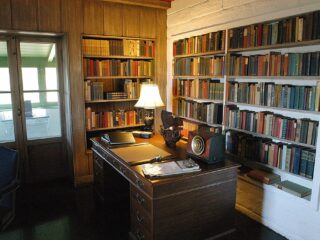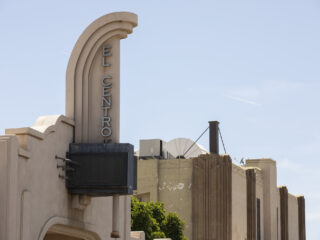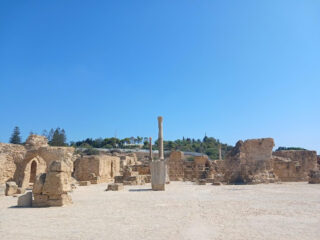by David Sclar
The city of Florence, Italy, is the unmistakable home of the great painter, architect, and sculptor, Michelangelo Buonarroti, known today simply as Michelangelo. The second of five sons to Ludovico di Buonaorotto Simoni, he was born in 1475 in the nearby village of Caprese but always considered himself a “son of Florence.” Today, one needs not look long or hard to witness Michelangelo’s influence on the city. His tomb is displayed prominently alongside those of Machiavelli, Galileo, and Rossini, and many of his most famous works of sculpture are housed throughout Florence – including, the magnificent statue of David.
Michelangelo was actually born outside the city boundaries, and he spent many of his youngest years with a wet nurse in a family of stonecutters. His childhood among this hard-working stonecutter family was lacking in affection. Michelangelo essentially grew up without a maternal influence, for his mother was too sick to nurse him and died when he was only six. His stepmother did provide for him but was generally too occupied with running the household to exert a tender influence on the young boy. Still, Michelangelo found his own inspiration in the skilled craftsmanship of the stonecutters. It was in the stone quarries of his youth that Michelangelo began his life-long loving relationship with stone – marble in particular. Michelangelo shared that love for stone with all of Tuscany: Irving Stone, author of the famous biography of Michelangelo, The Agony and the Ecstasy, has written that “the Tuscan treats stone with the tenderness that a lover reserves for his sweetheart,” and Tuscans affectionately refer to their native marble as pieta serena, or “serene stone.”
Michelangelo faced a daunting challenge in pursuing a career as a sculptor. No one was more acutely aware of the potential for failure in this field than his father, who possessed a nearly obsessive concern for the status and wealth of the Buonarroti family. The Buonarroti family had developed its fortune and its prestige by serving in numerous official posts, beginning in the middle of the thirteenth century. They belonged to the Money Changers Guild, and money lending was a well-respected profession in the Florentine community. However, the family’s influence and wealth had declined in the years preceding Michelangelo’s birth. The number of official posts maintained by the Buonarroti also dwindled. Michelangelo’s father, Ludovico, was one of the last Buonarroti to serve in such a position, and he was a podesta (a visiting mayor) in the mountainous region outside Florence where he held relatively little influence.
Ludovico actually spent much of his time and effort tracking the Buonarroti family history and tallying up their expenses. He took great pride in the family’s noble history and in the fact that no Buonarroti had made a living working with his hands. Thus, he was especially dismayed when the young Michelangelo, professed his desire to pursue a career as an artist. In his father’s eyes, Michelangelo seemed determined to waste his intelligence and his potential to enjoy wealth and high status on artistic pursuits. Certain that Michelangelo would not only meet with failure but also continue the family’s decline in influence, Ludovico tried his best to frustrate his son’s artistic ambitions. He beat his son, ignored his talent, and then sapped Michelangelo’s earnings when the boy began to meet with success.
Remarkably, Michelangelo’s stubborn commitment to his ambitions as a sculptor helped him to surpass the obstacles that his own father placed before him. In order to gain his father’s approval for his first apprenticeship, Michelangelo, then thirteen, succeeded in persuading the fresco painter Domenico Ghirlandaio to pay him for coming to study, rather than the other way around. Still, one wonders how Michelangelo maintained his commitment to sculpture in the face of resistance – from his father early in his life and from religious opposition to the arts later in life. In fact, the arts in the Tuscan region were never entirely secure in their freedom from suppression or censorship. The religious followers of Girolamo Savonarola, who came to power in the 1790s, denounced all art except what he deemed pious treatments of religious subjects. Michelangelo’s own brother, Lionardo, was among those followers and repeatedly attempted to persuade him to destroy his early works.
The only truly satisfactory answer comes from visiting the city of Florence, where Michelangelo found his inspiration, his home for many years, and his employment in the courts of various Medici family rulers. Florence’s respect for the arts and its history of artistic achievement encouraged Michelangelo’s determination and his passion for the arts. His love for sculpture was supplemented by the works of art and architecture that flourished in his surroundings. While centuries have passed since Michelangelo walked the streets of Florence, a visit to this remarkable Tuscan city seems to instill a sense of how well the personalities of the city and the artist complemented and no doubt once inspired each other. Florence, as any visitor can attest, is a remarkable city. Young men in Michelangelo’s time were supposedly known to sing romantic ballads to the city; a popular verse crooned:
Italy is the garden of Europe,
Tuscany is the garden of Italy,
Florence is the flower of Tuscany.
While exploring Florence, one wanders among an endless series of grand piazzas. Colorful but stately building facades surround the visitor on all sides and showcase sculptures that serve as the piazza’s centerpieces. The smooth gray stone streets are very pleasing to travel, and remarkable works of architecture await around nearly every corner: these include the magnificent Duomo – adorned by a dazzling pattern of green, white and red stone – and the Palazzo Veccio – the medieval castle and palace of the Medici ruling family where a copy of the statue of David is on display. The city is easily navigable, so one moves between piazzas, frescos, and artwork as if Florence were a walking museum.
Michelangelo was inspired by the accomplishments of Florence’s past artists. As a young sculptor working in his apprenticeships, Michelangelo learned to love the frescos in the Church of Santa Maria Novella, Donatello’s statues in the Medici palace, and the immense bronze doors by Lorenzo Ghiberti at the Baptistery. Upon witnessing the inspirational appeal of the arts in Florence, it becomes much easier for us to understand Michelangelo’s remarkable commitment to working as a sculptor. Though he was forced to pursue his love for sculpture without his family’s approval, Michelangelo found his ambition supported instead by his surroundings in his beloved home city. He could take pride in the glory of Florence’s artistic past, while hoping to someday make his own contribution to Florence’s portfolio.
In fact, one can’t help but see a resonance between the personalities of the city of Florence and the sculptor Michelangelo. Florence is a proud city – not boastful, but clearly self-important. Contrast, for example, the rounded arches that adorn Florence’s most important buildings with the narrow, jagged arches that decorate the palaces in Venice. Whereas the Venetian arches seem to aggressively seek the attention of their audience, the Florentine buildings take themselves seriously without striving to attract attention; Florence’s repeated archways stand noble and firm, seemingly secure in their own grandeur. Michelangelo’s own proud and hard-working personality seems to parallel the nature of his environment. He was not arrogant about his talents; instead he simply pursued his love for sculpture with intense devotion and with the greatest of skill. Michelangelo was always focused on his work, kept to himself, and was known to have a strong, if not intransigent, personality. As much a laborer as an artist, he would often grow thin from not eating while he worked day and night on a new project. It is remarkable to think that he risked the punishment of death in order to perform autopsies on the recently dead so that he could to better understand human anatomy. The power and purity of his works are the result of both his dedication and his natural talent as an artist.
Michelangelo’s devotion to his work also carried him through the turmoil that plagued the city of Florence during his lifetime. The city has not always been as secure in its attitude towards the arts. Florence has always simultaneously valued its history, tradition, and religion at the same time as it has honored its artists, its intellectual thinkers, and their progressive new ideas. Michelangelo’s growth as an artist flourished in the court of Lorenzo de Medici where humanism – the idea that religion and scientific knowledge can exist side-by-side – was endorsed by the ruling family. However, before the turn of the 16th century, a civil war divided a society that was conflicted between its respect for religion and its love for the arts. Thus, Michelangelo was forced to spend many of his later years working in other cities, including Bologna and Rome, as well as working for many different patrons and commissions throughout his lifetime. He learned to consistently align himself with those who would protect and endorse the arts, including numerous Popes who continually summoned him to Rome and demanded his services.
It was Pope Julius II who brought Michelangelo to Rome to paint the ceiling of the Sistine Chapel. Michelangelo was initially summoned in 1505 for the task of constructing a massive tomb for the Pope, but before he could complete the tomb, he was enlisted in the even larger endeavor of painting the Sistine Chapel from 1508-1512. Remarkably, Michelangelo’s determined personality compelled him to work alone on the task of painting this enormous ceiling. Spending hours on end on a scaffold high above the ground, he only allowed his assistants the minor role of bringing him materials such as plaster and paint. Michelangelo actually accepted the job reluctantly and with disappointment that he would not have the opportunity to sculpt. Yet, even while painting, Michelangelo found the power to depict the human form with an appreciation and intensity that belied his love for sculpture. His pictorial narratives of the story of Genesis and the “Last Judgment,” which he painted above the chapel’s altar from 1536-1541, are perhaps most compelling because of their striking ability to express the glory of human beings as well as the agony of human suffering.
Michelangelo’s great talent in all of the arts was acknowledged and acclaimed throughout Italy by the time he finally succumbed to a fever in 1564, at the age of 89. During his later years, Michelangelo was rather lonely and troubled by continued political turmoil – such as the sack of Rome in 1527 and the collapse of the Florentine Republic in 1530 – and the death of many of his closest friends in the preceding decades. He found solace in the same sources upon which he had always relied, his faith in God (he wrote to his nephew, Lionardo, “Many believe – and I believe – that I have been designated for this work by God”) and in sculpture. During nightly labors with his chisel, he designed a “Pieta” for his own tomb. In his spoken will on his deathbed, he said he left “his soul to God, his body to the earth, and his material possessions to his nearest relations.”
One wonders if by the “earth” he meant specifically the fertile region of Tuscany and the picturesque city of Florence spread out along the banks of the Arno River. Through most of his career, Michelangelo had returned to Florence when the opportunity arose and his art was in demand by those in power. It was there that he won the commission to sculpt the giant, muscular, and perfectly-proportioned statue of David from 1501-1504; it is there that his tomb is glorified in the Santa Croce Church (his nephew stole his remains from Rome to bury them at the Florentine church where Michelangelo had wanted to be buried); and it is there that his family finally learned to celebrate his life and work by establishing, in 1612, a resourceful and perhaps under-appreciated museum in his honor: the Casa Buonarrati.
Today, Florence is home to Michelangelo’s Bacchus, Madonna and Child, Battle of the Centaurs, Madonna of the Stairs, Crucifixion, David, Captives, Victory, and Piet, as well as the Medici Madonna and the Medici tombs. Michelangelo’s greatest sculptures are almost all housed in Florence, and we must remember that sculpture was always the artist’s strongest passion. Whatever ambivalence about the arts Florence may have harbored in the past, today the city is clearly a proud home to its “son.” Michelangelo’s life and sculpture are intertwined with the history and character of the city. His remarkable works, on display throughout Florence, ensure that the “Flower of Florence” remains to a source of inspiration for contemporary and future generations of artists.
David Sclar is graduating from Harvard University this year. He grew up in Newton, MA, and he is a former intern at The Atlantic Monthly.
More on the Web:
Images of Michelangelo’s Sculpture








